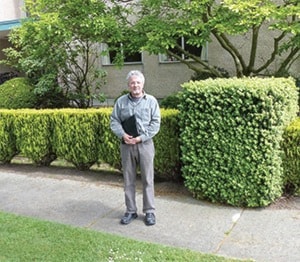Oak Bay is one of the oldest neighbourhoods in Greater Victoria, and that historic charm is one of the many features that draws people to the area.
That charm comes with a down side, however, in that some homes do not meet today’s rapidly changing building code.
Martin Kent, an Oak Bay home inspector and owner of Fairhome Building Inspectors, can attest to this. “I was inspecting a 100-year-old house not too long ago that had a stone foundation. The house was alright, I just told (the homeowners) to repair the cracks (in the foundation) that had formed over the years.”
Kent admits this year has been busier compared to previous years. “The market’s really changed. There are often multiple offers on properties which makes it difficult for realtors and home inspectors because the buyers are often hurried,” he says.
Kent, a licensed and Canadian Association of Home and Property Inspectors-certified home inspector, says basement leaks are one of the most common issues in Oak Bay’s older homes.
“Older homes have cement or clay drainage tiles,” he says of the outdated technology.
Basement leakage issues may stem from issues in the house’s foundation which may have been caused due to a buildup of water around the foundation, creating a porous foundation. Rectifying the leakage can depend on the state of the drainage tile. In some cases they can be repaired, other times they need to be replaced.
The roof is another issue Kent commonly sees in older homes.
“Most people don’t change their roof until someone tells them about it,” he says.
Moss buildup on and under the shingles is also a common problem in leafy Oak Bay, however moss can simply be removed through a de-mossing process, a much more cost-effective approach than replacing the whole roof, as long as the shingles are in good shape.
“Roofs can either be repaired or replaced, depending on the age and the condition of the roof,” Kent says.
Asbestos is also a common substance that Kent finds in Oak Bay’s homes. “Every (older, non-renovated) house has asbestos in it,” he says.
Areas asbestos can be found include the home’s heating system and attic.
“Vermiculite was a type of insulation used in the 1970s,” says Kent, who cautions this type of insulation contains asbestos as well.
He recommends immediate removal of the vermiculite, as well as any other potential sources of asbestos, as these products have been proven harmful to one’s health should they be exposed to it.
Costs for asbestos removal can be high due to the process required to contain the material and limit human exposure. Not only are newer insulation materials better for our health, but they also do a much more effective job of insulating a home, which can pay dividends in the form of savings on a monthly heating bill.
Kent also recommends replacing knob-and-tube wiring when he sees it during his home inspections. Knob-and-tube is a type of wiring that doesn’t have a ground wire with it.
Although it can still be found in certain industrial environments, it is being replaced in modern home design in favour of more modern, safer techniques, which are also better at handling the heavy power draw needed for today’s electronics and appliances.
The final big red flag Kent finds in Oak Bay homes is buried oil tanks. “It was very common to have buried oil tanks. Before 1953, they used to bury the tanks,” he says.
The tanks were viewed as unsightly by homeowners, and so were hidden underground. These buried oil tanks can cause some obvious issues, not the least of which is when the tank begins to corrode due to age and develop leaks, allowing the oil to seep directly into the soil.
Kent suggests updating the heating system with more modern and efficient technology. Electric heat pumps are becoming much more favourable.
